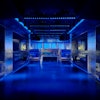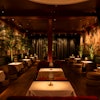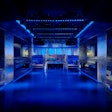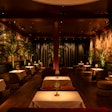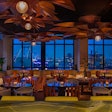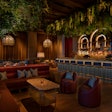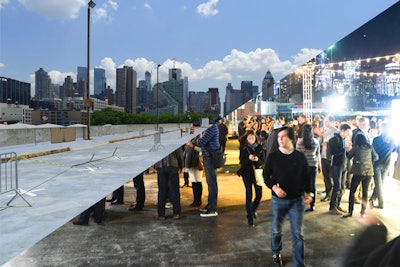
The New York City Wine & Food Festival presented by Food & Wine descended once again in a flurry of culinary demonstrations, private dinners, tastings, and parties for its sixth run this weekend, featuring a mix of returning signature events and newly launched bashes. This year, the festival concentrated the majority of its activity around a central hub at Piers 92 and 94 in Midtown Manhattan in an effort to make the events more spacious and easier to navigate.
Randy Fisher, the president and founder of Culinary Related Entertainment and Marketing (Cream), and his senior partner Kali Elias Bensaadon have been involved in the New York City Wine & Food Festival since they produced the city’s inaugural Burger Bash in 2008 at the Tobacco Warehouse in Brooklyn. But this year brought a new challenge: Festival organizers presented the duo with the task of producing three different high-profile events within 72 hours, all to be held atop the third level of an open-air parking structure at Pier 92 adjacent to the West Side Highway. In addition to the popular Blue Moon Burger Bash held on Friday evening, the job included designing two brand-new events to the festival: Jets & Chefs: the Ultimate Tailgate on Saturday, the weekend’s only kid-friendly event featuring 28 chefs cooking up gridiron classics; and La Sagra Sunday Slices, a pizza-centric affair showcasing 15 of New York’s best-known pizzaioli (pizza chefs). Adding to the challenge of flipping the parking deck for three distinct, back-to-back events to accommodate 100 chefs and 9,000 guests was the fact that the completely raw space had no running water, electricity, or other typical venue amenities.
We spoke to the veteran culinary event producers about how they pulled it all off, and asked them to share tips for avoiding common food festival pitfalls.
What did you think of the festival’s decision to move all these major events to one main location, as opposed to past years when they’ve been spread out across the city?
Fisher: I think the idea was to have a culinary campus, so there was almost a university-like setting of all of these events together. And I think it ended up working really well. Kali and I are used to these remote locations, and we like that as well—it allows us to explore what we can do on our own. But when you get everybody together and there’s an amalgamation of efforts, it does bring some great synergy to the overall event planning. So I think in hindsight it was a great move, I think the facility worked well, but there were definitely some challenges—the first year is always tough. We’re used to bouncing from venue to venue. But Cream is always being given these more challenging event spaces where events haven’t even occurred before, and that’s what happened here.
I think the facility itself was surprised that we could pull it off and be met with the success that we had. Because when you’re working somewhere every single day for years and you only think of it as a parking lot and then it transforms into this outrageous culinary event—they were pretty shocked. Kali and I always joke about the fact that Cream never gets a chance to produce in a ballroom with bathrooms, carpet, and running water. We typically have to build the entire venue ourselves and this was no exception.
What would you say was the biggest challenge of the whole weekend?
Fisher: The ability to turn the event space in 24 hours, and in some cases less than 24 hours, like from the Burger Bash to the Tailgate [the next day at 2 p.m.]. To be able to turn the event space, and to give the respect to the ticket purchaser that every time he walks in it’s going to be a brand-new venue that’s perfectly clean—I think that was the most challenging. And with the event space itself already presenting physical challenges, that was exacerbated by the fact that we had to turn it three times.
It was pretty much unprecedented in the festival’s history, to have back-to-back events like that in that short of a time period. But, in each case, from Burger Bash, to Tailgate, to Sunday Slices, the gates opened before the stated general admission time, whether it was a minute or sometimes several minutes. That’s what Kali and I really strive for. If it starts at 2 p.m., we want to open at 1:59 p.m. We were able to do that, so we were very satisfied. The guest expectation is, I think in a lot of cases, if the event starts at 2 p.m., they don’t think they’re going to get inside the gates until 2:15. But we’re hospitality driven, and so the guest experience for us is the most critical. If you can open up a little bit early and beat the expectations of the client—which is the guest—then you’re ahead of the game.
As producers, what other tactics do you employ at tasting events to make the experience better from a guest’s standpoint?
Fisher: We always plan from the aesthetic front-of-house perspective. So, for example, we have no tolerance for garbage, so we always maximize the amount of places to put it. We double up on staff for purposes of clearing plates. We work very hard on guest flow and making sure the spacing is appropriate. And then we do little things we call “Creaming” it: If there are lines—and we know that lines are the bane of our existence, nobody likes to wait in line for anything—we try to make the experience a more positive one by having waiters pass food and wine to people while they’re in line. It really makes it much more enjoyable.
The majority of the parking deck was covered with a 35,000-square-foot specialty tent structure, but some of the 40 chef tents, guest seating, and activations were out in the open. Was there a contingency plan in case of bad weather?
Fisher: The only back-up plan was run like hell! [Weather is] the one thing in this business that you can’t control. Rain typically is the budget buster. There are not unlimited budgets, but we do our best to respect the budget and at the same time present a venue that is comfortable and pleasing to the eye. This particular venue, once you walked in and turned around and saw that beautiful cityscape, at all different times of the day—at night it was spectacular, during the day it was spectacular—that was special. The nice thing about this venue was we had two very large tent structures where we could have accommodated almost all of the guests. Now, it would have precluded the chefs in the courtyard from really showing off their food, but it would have provided them shelter as the rain passed, so that was really the plan. Listen, we got lucky. We’ve produced events where there has been rain—a couple years ago we did Burger Bash in Brooklyn at the Tobacco Warehouse, and it rained right at the end, everybody went into the tent, and the band cranked it, and it ended up being perfectly fine. The food was great this year, so people were content, and I think they still would have been happy if it was a little colder even. But we got lucky with the weather.
You brought in all of the cooking equipment, as well as four custom-built walk-in refrigeration units for the chefs. Of the three events, was any one more difficult to set up from a food preparation standpoint?
Fisher: As equally important as the guest is, we think, the chef. If you don’t make the chef happy, you can’t have these events, and you can’t have chefs return year after year. So we pride ourselves on creating these makeshift kitchens that really service the chef to the best of our abilities. We only rely on them for their food—we handle building these specified, unique kitchens for each chef. So we’ll present them with three or four different kinds of cooking devices to choose from, and we bring in temporary refrigeration they can use, as well as service tables.
The event that had the most difficult issue to overcome was the pizza event—it had never been done before, with wood-burning ovens. There have been events where they served pizza, but we had 20 wood-burning ovens on that deck and we brought them in from three or four different suppliers. We brought in deck ovens, wood-burning ovens, convection ovens—that was the most challenging event from a cooking equipment perspective. But when we saw these ovens being heated up—they had to be brought to temperature, a process that started at 10 in the morning for the 4 p.m. start time, we, I’m almost embarrassed to admit, were pinching ourselves that it all came together. The cool thing for us is that people have wanted to do pizza events across the country, and I think we’ve come up with a solution on how to do it, and I think we’ve come up with some great partners that will allow us to do this across the country as well.
How do you manage all the waste at these events, while trying to stay as eco-friendly as possible?
Fisher: Obviously the trend is to be as green as possible. This year we had a partner in Plastics Make It Possible, which provided us with recycling bins. And we utilized clear trash bags and tried to really educate the consumer on what to put where. At this point in the event business I think it’s almost nearly impossible to be 100 percent successful with green initiatives, but I think that since we’ve started, which was 10 years ago, we’ve come a long, long way.
We spend a lot of time on educating our staff ahead of time, we have a full protocol that we put everyone through, and we train our volunteers and our paid staff on how to handle the garbage. But when we have partners like Plastics Make It Possible, it helps amp up the green effort and allows us to be more successful. Cream has always tried to run environmentally friendly events, and I think we’re learning, as the industry learns, how to be more successful at that. I think people appreciate [staffers standing near trash bins encouraging them to recycle]. Sometimes it’s a little bit of an effort, but it brings a sense of consciousness to how we throw things away. So the message hopefully that guests bring back to their homes is that they think before throwing something out.
What are some of the most common mistakes event planners make when putting together food events, and what are your solutions?
Fisher: I think a lot of thought has to be given to curating the menu. A tremendous amount of thought has to be given to the flow of food into the event, the chef load in and load out—really looking to the interests of the chef, who is being asked to get outside of his kitchen and his comfort zone to produce his best fare for, in our case at each event, 3,000 guests. I also think that a lot of thought has to be given to the food preparation and food safety. We’ve been lucky, I’m almost afraid to say this out loud, but we’ve been very lucky in regards to people not becoming ill after any of these events, as you can imagine with all this raw meat and seafood. We give a lot of deference to food safety and we really push chefs to maintain refrigeration and to treat food in a way that’s going to be safe for our consumers.
Bensaadon: I think we’ve all seen the walk-around tasting event, and Randy and I really try to strive to keep it exciting and push chefs to their limits. Especially on the Tailgate menu—with Burger Bash and pizza, you kind of expect what you’re getting into, but for Tailgate we looked to our chefs to really push the envelope on creating the best-in-class tailgate dish. We worked with our chefs closely and changed menu items a couple times to make sure that it was a dish that was appropriate for the entire guest list, knowing that it was an all-ages event. It needed to be something that was approachable for both kids and adults.
At the same time, it’s the New York City Wine & Food Festival, and there’s a level of expectation from our adult crowd, so it’s that balance of what’s appropriate. For example, [the restaurant] Cannibal did a tripe chili dog, so the kids could have a hot dog, but if parents wanted to up the game, they topped it with the tripe chili. And for Burger Bash as well, we’ve seen the traditional burger and also things that you would never expect to be put on a burger. When Randy and I curate the menus for our events, we really try to push the limits, and I would encourage other event producers in the culinary space to do the same—you can only eat so many ceviches at a tasting event. And Randy and I really enjoy working with the chefs on that process.
Fisher: The other thing, when we’re curating menus, is that we frown on the chaffing dish concept. Also, the cold canapé. I realize that there are always limitations on hot cooking within buildings and ballrooms, but that’s why we really enjoy these super challenging outdoor venues, because the best-kept secret is that it allows us so much more leeway from a culinary standpoint.


